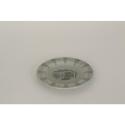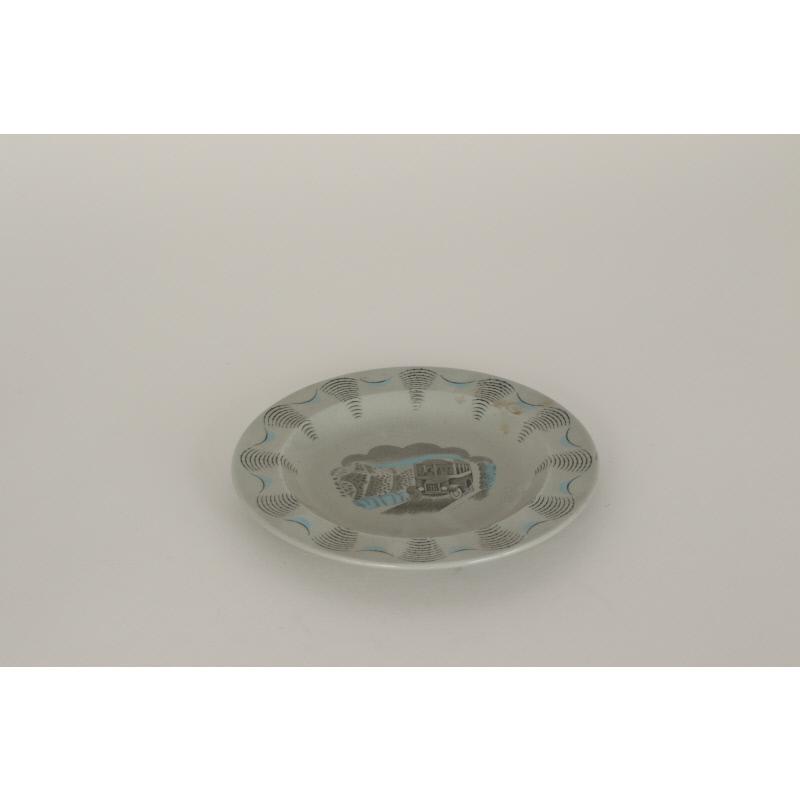Currently indexing
Side plate
Classification(s):
Pottery
Date: 1938
Designer: Eric William Ravilious
Organisation: Wedgwood (English, founded 1759)
Dimensions:
15 × 154 mm (1.5 × 15.4 cm)
Medium: Lead-glazed earthenware
Object number: CC074
Place of Production:England
Title:Travel
DescriptionLead-glazed earthenware side plate, designed by Eric Ravilious in 1938 and manufactured by Wedgwood. Made in England. The side plate is part of the ‘Travel’ series. The shape is ‘concave’. The design is transfer printed and hand finished. To the centre of the plate is a scene depicting a bus driving on a country lane. The edge of the plate is decorated with a pattern of wavy lines.
Base stamp “Travel designed by Eric Ravilious Wedgwood of Etruria & Barlaston Made in England”. Stamped underneath the glaze “Wedgwood” (partially obscured). A paper label is attached “Pattern no. TK 472 Travel Plate 5” Concave shape”.
Base stamp “Travel designed by Eric Ravilious Wedgwood of Etruria & Barlaston Made in England”. Stamped underneath the glaze “Wedgwood” (partially obscured). A paper label is attached “Pattern no. TK 472 Travel Plate 5” Concave shape”.
ProvenanceThis object was originally acquired for the Inner London Education Authority’s (ILEA) ‘Circulating Design Scheme’ collection.
The collection was instigated by the London Country Council (later the Greater London Council) and the Council of Industrial Design (COID). The collection’s original purpose was concerned with the teaching and dissemination of modern, ‘good design’.
The collection was established in 1951/52 as the ‘Experiment in Design Appreciation’, later renamed the ‘Circulating Design Scheme’.
The Circulating Design Scheme lent boxed showcases to London schools. The showcases contained handling objects, material samples and interpretation on a specific subject.
COID withdrew its involvement in the Scheme in 1957. After which time, it was managed exclusively by the London County Council from 1957-1963.
After the administrative restructuring of London authorities, the Scheme was jointly managed by the Greater London Council and the Inner London Education Authority (ILEA) from 1963 – 1976.
The Scheme was operational until 1976 when the collections were withdrawn from circulation. ILEA was abolished in the late 1980s and the collection was donated to Camberwell College of Arts in 1989/90.
ILEA was responsible for secondary and tertiary education in the inner London boroughs, this included Camberwell.
The collection was instigated by the London Country Council (later the Greater London Council) and the Council of Industrial Design (COID). The collection’s original purpose was concerned with the teaching and dissemination of modern, ‘good design’.
The collection was established in 1951/52 as the ‘Experiment in Design Appreciation’, later renamed the ‘Circulating Design Scheme’.
The Circulating Design Scheme lent boxed showcases to London schools. The showcases contained handling objects, material samples and interpretation on a specific subject.
COID withdrew its involvement in the Scheme in 1957. After which time, it was managed exclusively by the London County Council from 1957-1963.
After the administrative restructuring of London authorities, the Scheme was jointly managed by the Greater London Council and the Inner London Education Authority (ILEA) from 1963 – 1976.
The Scheme was operational until 1976 when the collections were withdrawn from circulation. ILEA was abolished in the late 1980s and the collection was donated to Camberwell College of Arts in 1989/90.
ILEA was responsible for secondary and tertiary education in the inner London boroughs, this included Camberwell.
NotesEric Ravilious won a scholarship to study at the Royal College of Art in the 1920s. Under Paul Nash, Ravilious became an accomplished wood engraver. He was an accomplished designer across many disciplines - he produced designs for books, textiles, advertising and glass. In 1936 Wedgwood commissioned him to produce a commemorative mug for the coronation of King Edward VIII. Ravilious created many illustrated tea services for Wedgwood including Afternoon Tea (1937), Travel (1938) and Garden (1939). He became an official War artist in 1939.







